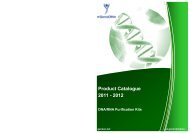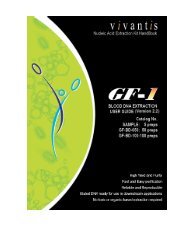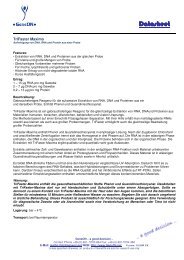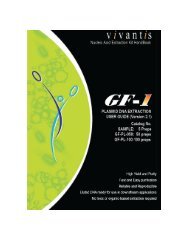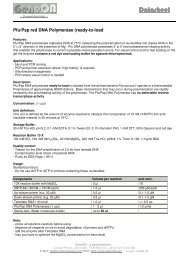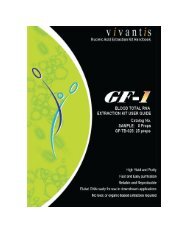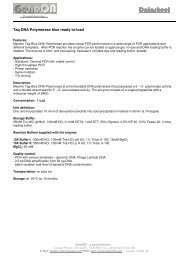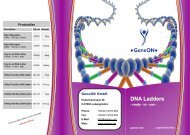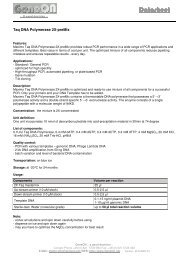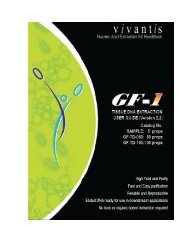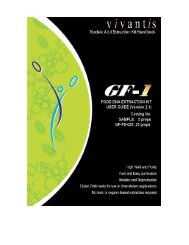Total RNA Extraction Kit: Manual
Total RNA Extraction Kit: Manual
Total RNA Extraction Kit: Manual
You also want an ePaper? Increase the reach of your titles
YUMPU automatically turns print PDFs into web optimized ePapers that Google loves.
Introduction<br />
The GF-1 <strong>Total</strong> <strong>RNA</strong> <strong>Extraction</strong> <strong>Kit</strong> is designed for the isolation of total <strong>RNA</strong> (longer than<br />
200 bases) from a variety of sources such as animal tissues, bacteria cells and cell cultures.<br />
Samples are lysed in the presence of a specially formulated buffer which inactivates cellular<br />
RNases. Meanwhile, fragments of DNA are simply removed by applying the sample into a<br />
specially designed homogenization column followed by DNase I treatment. Optimized buffer<br />
and ethanol are added to provide selective binding of <strong>RNA</strong> onto the column matrix while<br />
contaminants are efficiently washed away. High-quality <strong>RNA</strong> is then eluted in RNase-free<br />
water. Isolated <strong>RNA</strong> is ready for use in downstream applications such as dephosphorylation,<br />
kinasing, blotting, cDNA synthesis, etc.<br />
<strong>Kit</strong> components<br />
Product<br />
Catalog No.<br />
5 Preps<br />
SAMPLE<br />
25 Preps<br />
GF-TR-025<br />
Components<br />
<strong>RNA</strong> binding columns 5 25<br />
Homogenization<br />
5 25<br />
columns<br />
Collection tubes 10 50<br />
Buffer TR* 4ml 20ml<br />
Inhibitor Removal<br />
1.5ml<br />
8ml<br />
Buffer*<br />
Wash Buffer* 3ml 15ml<br />
DNase I* 0.04ml 0.2ml<br />
Digestion Buffer 0.35ml 2ml<br />
Digestion Enhancer 0.04ml 0.2ml<br />
RNase-free Water 1ml 5ml<br />
Proteinase K* 0.06ml 0.3ml<br />
Handbook 1 1<br />
* Please refer to Reconstitution of Solutions and Storage and Stability.<br />
The GF-1 <strong>Total</strong> <strong>RNA</strong> <strong>Extraction</strong> <strong>Kit</strong> is available as 25 purifications per kit.<br />
The reagents and materials provided with the kit are for research purposes only.
Additional Materials to be Supplied by User<br />
80% Ethanol<br />
Absolute Ethanol (>95%)<br />
2-mercaptoethanol<br />
Lysozyme (Bacterial <strong>RNA</strong> Purification)<br />
Lyticase/ Zymolase (Yeast <strong>RNA</strong> Purification)<br />
Reconstitution of Solutions<br />
The bottle labeled Inhibitor Removal Buffer and Wash Buffer contain concentrated buffer<br />
which must be diluted with absolute ethanol (>95%) before use.<br />
For SAMPLE (5 preps),<br />
Add 1.5ml of absolute ethanol into the bottle labeled Inhibitor Removal Buffer.<br />
Add 7ml of absolute ethanol into the bottle labeled Wash Buffer.<br />
For GF-TR-025 (25 preps),<br />
Add 8ml of absolute ethanol into the bottle labeled Inhibitor Removal Buffer.<br />
Add 35ml of absolute ethanol into the bottle labeled Wash Buffer.<br />
Store Inhibitor Removal Buffer and Wash Buffer at room temperature with bottle capped<br />
tight after use.<br />
DNase I is sensitive to physical denaturation. DO NOT VORTEX. Mix gently by inverting the<br />
tube.<br />
Prepare DNase I in 7µl aliquots to avoid repeated freeze-thaw cycles. Store at -20°C.
Storage and Stability<br />
• Store all solutions (EXCEPT DNase I) at 20°C-30°C.<br />
• Store Proteinase K at -20°C.<br />
• Store DNase I at -20°C.<br />
• Buffer TR is stable for 1 month after addition of 2-mercaptoethanol (prepare as<br />
needed).<br />
• <strong>Kit</strong> components are guaranteed to be stable for 12 months from the date of manufacture.<br />
Buffer TR and Inhibitor Removal Buffer may exhibit salt precipitation due to cold<br />
temperature. If this occurs, simply warm the bottle at 55°C - 65°C with occasional<br />
mixing until completely dissolved.<br />
Chemical Hazard<br />
Buffer TR and Inhibitor Removal Buffer contain guanidine salts which can be harmful when<br />
in contact with skin or swallowed. Always wear gloves and practice standard safety<br />
precautions. Do NOT disinfect guanidine or extraction waste in solutions containing bleach or<br />
any form of acid. To clean any items contaminated with the reagent, simply soak in detergent<br />
and water to remove all traces of guanidine before cleaning with bleach or acidic solutions.
Procedures<br />
All steps are to be carried out at room temperature unless otherwise stated.<br />
Do not exceed the maximum recommended starting volume of sample to prevent<br />
reduction in yield and purity.<br />
Be certain not to introduce any RNases during the whole purification process.<br />
Wear gloves at all times.<br />
Add 10ml of 2-mercaptoethanol into 1ml of Buffer TR before use. Buffer TR is<br />
stable for 1 month upon addition of 2-mercaptoethanol.<br />
For each purification, prepare the DNase I Digestion Mix as follows<br />
(Prepare as needed):<br />
DNase I 7µl<br />
Digestion Buffer 56 µl<br />
Digestion Enhancer 7 µl<br />
Mix the DNase I Digestion Mix by gentle pipetting (DO NOT VORTEX).<br />
Store the DNase I Digestion Mix on ice while performing the initial steps of <strong>RNA</strong> extraction.<br />
I. Sample preparation<br />
A. Animal Tissue (Except Skeletal Tissue)<br />
Note 1: Do not use more than 30mg tissues.<br />
Note 2: Frozen animal tissue should not be allowed to thaw during handling.<br />
Note 3: It is more difficult to extract total <strong>RNA</strong> from skeletal tissue such as heart<br />
and muscle tissue with this standard protocol. Therefore, users are<br />
advised to use the protocol as described in Animal Tissue II to extract total<br />
<strong>RNA</strong> from heart and muscle tissue.
1. Grind animal tissue (maximum: 30mg) in liquid nitrogen to fine powder using a pre-chilled<br />
mortar and pestle. Place the ground material into a pre-chilled, RNase-free vessel of<br />
suitable size for homogenization at the next step.<br />
Ensure that the tissue is ground into fine powder to obtain a high yield of <strong>RNA</strong>. Frozen tissue should<br />
not be allowed to thaw during handling.<br />
2. Homogenize the tissue completely in 700µl Buffer TR by using a conventional rotorstator<br />
or any other suitable homogenizer.<br />
Ensure that 2-mercaptoethanol is added into Buffer TR before use.<br />
3. Centrifuge the sample at maximum speed for 3 min.<br />
4. Transfer the lysate into a Homogenization column assembled in a collection tube.<br />
Centrifuge at maximum speed for 2 min. Save the flow-through.<br />
5. Add 650µl of 80% ethanol to the flow-through. Mix thoroughly by pipetting. Do not<br />
centrifuge.<br />
Precipitate may form after the addition of ethanol.<br />
6. Proceed to ll. <strong>RNA</strong> Isolation.
B. Animal Tissue II (Skeletal Tissue)<br />
Note 1: Do not use more than 30mg tissues.<br />
Note 2: Frozen animal tissue should not be allowed to thaw during handling.<br />
1. Grind animal tissue (maximum: 30mg) in liquid nitrogen to fine powder using a pre-chilled<br />
mortar and pestle. Place the ground material into a pre-chilled, RNase-free vessel of<br />
suitable size for homogenization at the next step.<br />
Ensure that the tissue is ground into fine powder to obtain a high yield of <strong>RNA</strong>. Frozen tissue should<br />
not be allowed to thaw during handling.<br />
2. Homogenize the tissue completely in 300µl Buffer TR by using a conventional rotor stator<br />
or any other suitable homogenizer.<br />
Ensure that 2-mercaptoethanol is added into Buffer TR before use.<br />
3. Add 590µl water to the lysate, followed by addition of 10µl Proteinase K solution. Mix<br />
thoroughly by pulse vortexing. Incubate at 65°C for 10min.<br />
4. Centrifuge the sample at maximum speed for 3 min.<br />
5. Transfer the lysate into a Homogenization column assembled in a collection tube. Save the<br />
flow-through.<br />
6. Add 450µl of absolute ethanol to the flow-through. Mix thoroughly by pipetting.<br />
7. Proceed to ll. <strong>RNA</strong> Isolation.
C. Bacteria Cell<br />
Note 1: Do not use more than 1x10 9 bacteria as this will overload the column.<br />
Note 2: Prepare lysozyme of the recommended concentration in TE buffer<br />
pH 8.0.<br />
For Gram-negative bacteria, prepare 0.5mg/ml.<br />
For Gram-positive bacteria, prepare 5mg/ml.<br />
1. Pellet bacteria from culture grown to log phase or early stationary phase by centrifugation<br />
at 6,000 x g for 5 min at 4°C. Discard the supernatant completely.<br />
Do not use more than 1x10 9 bacteria.<br />
2. Resuspend the bacteria pellet in 100µl of<br />
a) 0.5mg/ml lysozyme for Gram-negative bacteria strains. Mix by vortexing and<br />
incubate at room temperature for 3 - 5 min.<br />
b) 5mg/ml lysozyme for Gram-positive bacteria strains. Mix by vortexing and incubate<br />
at room temperature for 5 - 10 min.<br />
Ensure that the lysozyme used is prepared in TE buffer.<br />
3. Add 350µl Buffer TR to the sample.<br />
Ensure that 2-mercaptoethanol is added into Buffer TR before use.<br />
4. Transfer the lysate into a Homogenization column assembled in a collection tube.<br />
Centrifuge at maximum speed for 2 min. Save the flow-through.<br />
5. Add 300µl absolute ethanol to the flow-through. Mix thoroughly by pipetting. Do not<br />
centrifuge.<br />
Precipitate may form after the addition of ethanol.<br />
6. Proceed to II. <strong>RNA</strong> Isolation.
D. Cell Culture<br />
Note 1: Do not use more than 1x10 7 cells as it will overload the column.<br />
1. Pellet cell culture in a microcentrifuge tube at 1,000 x g for 5 min.<br />
Do not use more than 1x10 7 cells.<br />
2. 2 Add 350µl Buffer TR to the cell pellet. Mix thoroughly by vortexing vigorously.<br />
Ensure that 2-mercaptoethanol is added into Buffer TR before use.<br />
Volume of Buffer TR is added according to different number of cells,<br />
If number of cells is
E. Plant Tissue<br />
Note 1: Do not use more than 100mg tissues.<br />
Note 2: Frozen tissue should not be allowed to thaw during handling.<br />
Note 3: Certain plant tissues with high metabolites may solidify in Buffer TR;<br />
Therefore, users are advised to use Buffer HR (Cat. no.: GFHR025),<br />
which is sold separately.<br />
1. Grind plant tissue (maximum: 100mg) in liquid nitrogen to fine powder using a pre-chilled<br />
mortar and pestle. Place the ground material into a cold, RNase-free 2ml microcentrifuge<br />
tube.<br />
Ensure that the tissue is ground into fine powder to obtain a high yield of <strong>RNA</strong>.<br />
Frozen tissue should not be allowed to thaw during handling.<br />
2. Add 400µl Buffer TR or Buffer HR (refer to note3) to the ground tissue. Mix thoroughly<br />
by vortexing vigorously.<br />
Ensure that 2-mercaptoethanol is added into Buffer TR before use.<br />
3. Centrifuge sample at maximum speed for 3 min.<br />
4. Transfer the lysate into a Homogenization column assembled in a collection tube.<br />
Centrifuge at maximum speed for 2 min. Save the flow-through.<br />
5. Add 350µl of 80% ethanol to the flow-through. Mix thoroughly by pipetting. Do not<br />
centrifuge.<br />
Precipitation may form after the addition of ethanol.<br />
6. Proceed to II. <strong>RNA</strong> Isolation.
F. Yeast<br />
Note 1: Use only freshly harvested cells.<br />
Note 2: Do not use more than 5 x 10 7 cells as this will overload the column.<br />
Note 3: Prepare Buffer YL (1M Sorbitol, 0.1M EDTA) fresh for every purification<br />
by adding in 0.1% 2-mercaptoethanol and lyticase / zymolase<br />
(50U per 1 x 10 7 cells) before use.<br />
1. Pellet yeast cells by centrifugation at 5,000 x g for 5 min at 4°C. Discard the supernatant<br />
completely.<br />
Do not use more than 5 x10 7 yeast cells.<br />
2. Resuspend the cells in 1.5ml Buffer YL containing lyticase / zymolase and 0.1% 2-<br />
mercaptoethanol (refer note 3). Incubate at 30°C for 30 min to generate spheroplasts.<br />
Use only freshly harvested cells.<br />
3. Pellet the resulting spheroplasts by centrifugation at 1,000 x g for 5 min.<br />
4. Add 350µl Buffer TR to lyse spheroplasts. Mix thoroughly by vortexing vigorously.<br />
Ensure that 2-mercaptoethanol is added to Buffer TR before use.<br />
5. Transfer the lysate into the Homogenization column placed in a collection tube.<br />
Centrifuge at maximum speed for 2 min. Save the flow-through.<br />
6. Add 350µl of 80% ethanol to the flow-through. Mix thoroughly by pipetting. Do not<br />
centrifuge.<br />
Precipitate may form after addition of ethanol.<br />
7. Proceed to II. <strong>RNA</strong> Isolation.
II. <strong>RNA</strong> Isolation<br />
Attention! Tips for Higher Yield<br />
In order to obtain maximum yield, we strongly recommend users to fix the orientation of the column<br />
during centrifugation at all times. We recommend users to place the column which has a triangle mark<br />
on the edge, at a fixed position during centrifugation.<br />
1. Transfer the sample, including any precipitate into a <strong>RNA</strong> Binding Column assembled in a<br />
collection<br />
tube. Centrifuge at 10,000 x g for 1 min. Discard the flow-through.<br />
2. Add 500µl of Wash Buffer and centrifuge at maximum speed for 1 min. Discard flow<br />
through.<br />
3. Pipette 70µl of DNase I Digestion Mix into <strong>RNA</strong> Binding Column and incubate at room<br />
temperature for 15 min. Ensure the digestion mix is pipette directly onto the membrane.<br />
Some samples may have high genomic DNA content. Prolong the incubation time (need to be<br />
determined empirically) if necessary.<br />
4. Add 500µl of Inhibitor Removal Buffer and centrifuge at maximum speed for 1 min.<br />
Discard flow through.<br />
5. Add 500µl of Wash Buffer and centrifuge at 10,000 x g for 1 min. Discard flow-through.<br />
6. Repeat wash with 500µl of Wash Buffer and centrifuge at 10,000 x g for 1 min. Discard<br />
flow-through.<br />
7. Centrifuge the column at 10,000 x g for 1 min to remove traces of buffer.<br />
8. Place the column into a new microcentrifuge tube. Add 40-60µl of RNase-free Water<br />
directly onto the membrane and stand for 1 min. Centrifuge at 10,000 x g for 1 min. Store<br />
<strong>RNA</strong> at -20°C or -80°C.
Troubleshooting<br />
Please note that by not adhering to the recommended protocols, unsatisfactory results related to<br />
yield and quality of the <strong>RNA</strong> may occur. If problems arise, please refer to the following:<br />
Problem Possibility Suggestions<br />
Homogenization<br />
column clogged<br />
Insufficient sample<br />
disruption<br />
or homogenization<br />
Tissue sample need to be ground<br />
till become fine powder by using<br />
mortar pestle.<br />
Homogenize tissue sample with<br />
rotor-stator homogenizer or pass<br />
the homogenate through a 18-21<br />
gauge needle several times till<br />
visible tissue fragment is<br />
eliminated.<br />
Too much starting materials Reduce amount of starting<br />
material in the subsequent<br />
purification.<br />
Low <strong>RNA</strong> yield<br />
<strong>RNA</strong> degradation/<br />
smearing<br />
Lysate is too viscous<br />
Column is not placed at<br />
fixed orientation during<br />
centrifugation<br />
Absolute ethanol or 80%<br />
ethanol is not added prior<br />
loading lysate onto <strong>RNA</strong><br />
binding column<br />
80% ethanol is prepared<br />
wrongly<br />
Inhibitor Removal Buffer<br />
and Wash Buffer are<br />
reconstituted wrong<br />
Samples not properly<br />
stored<br />
Users may dilute homogenate<br />
with additional lysis buffer.<br />
Place the column which has a<br />
triangle mark on the edge, at a<br />
fixed position during<br />
centrifugation at all times.<br />
Repeat purification with new<br />
sample.<br />
Repeat purification with new<br />
sample.<br />
Please refer to "Reconstitution of<br />
Solutions". Repeat purification<br />
with new sample.<br />
Tissue sample should be flashfrozen<br />
immediately in liquid<br />
nitrogen prior storing at -70 ° C.
Problem Possibility Suggestions<br />
Inappropriate handling<br />
Frozen tissue sample should not<br />
be thawed during handling.<br />
Genomic DNA<br />
contamination<br />
Poor performance<br />
of eluted <strong>RNA</strong> in<br />
downstream<br />
Applications<br />
Absolute ethanol or 80%<br />
ethanol is not added prior<br />
loading onto <strong>RNA</strong> binding<br />
Column<br />
80% ethanol is prepared<br />
wrongly<br />
Lysate is not passed<br />
through Homogenization<br />
Column prior loading onto<br />
<strong>RNA</strong> Binding Column<br />
DNase I treatment is not<br />
performed properly<br />
Eluted <strong>RNA</strong> contains<br />
traces of ethanol<br />
<strong>RNA</strong> degraded<br />
Use disposable plasticware and<br />
plastic tips.<br />
Ensure that the purification is<br />
performed in an RNase-free<br />
environment.<br />
Wear gloves at all times.<br />
Repeat purification with new<br />
sample.<br />
Repeat purification with new<br />
sample.<br />
Repeat purification with new<br />
sample.<br />
Please refer to preparation of<br />
DNase I Digestion Mix and<br />
pipette the DNase I Digestion<br />
Mix directly onto the membrane.<br />
Ensure that the column is spun<br />
dried prior to elution.<br />
Please refer to problem "<strong>RNA</strong><br />
degradation/smearing".



